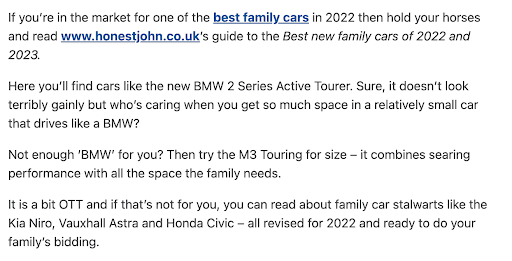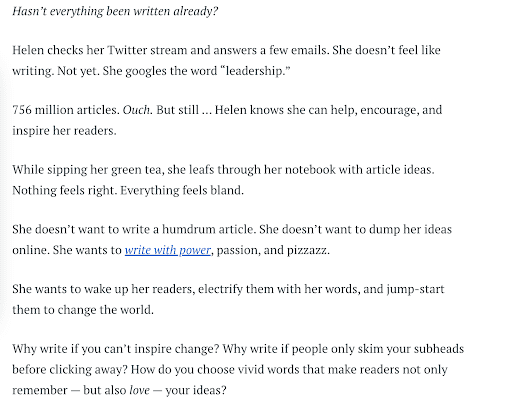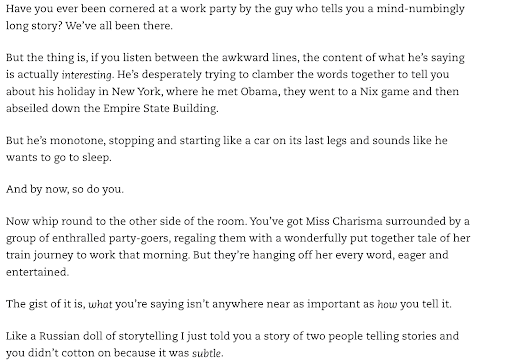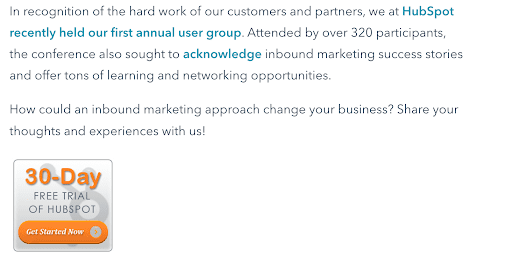The atmosphere is electric.
You’re at the newest cocktail bar in town.
The menu is HUGE.
You want something super special. Something fresh. Something that’s Insta-worthy that you can shout about.
So you go with a random pick.
Ugh. Bad choice.
It doesn’t taste of anything: weak, insipid, lost.
No substance.
The disappointment is real. And the one thing you know for sure is: I’m outta here, never to return.
This scenario is a common one (and not just for our poor, budding bartender).
Crafting customer-winning content is no different. Honest.
For your potential readers, the sea of content out there is vast. And with that vastness comes waves of dull and dreary blog posts, ebooks and whitepapers.
Enough to make any reader want to jump ship.
That’s where you come in.
You can create a perfectly mixed content cocktail by creating imaginative, useful and intoxicating content that’ll keep your readers captivated.
And now for the how.
Behold the cheat sheet to rule them all (the kind that’ll have you crafting the sort of magnetic copy that’ll put you a cut above the rest and keep the wins rolling on in).
First up…
#1 Creating value
Getting on board with content marketing and doing it the right way is one of the best things a brand can do. But only if done right.
The cool thing is, if a company is all over it, valuable content can build brand awareness, instill trust and help to form relationships that last.
Here’s how.
GIVE THE READERS WHAT THEY WANT
“We need to stop interrupting what people are interested in and be what people are interested in”.
Says Craig Davis (not to be confused with Craig David, who, to be fair, has his own special way with words). It’s actually the Former Chief Creative Officer at JWT. But Craig D’s still filling us in.
The thing is, no-one cares about reading company news. Let’s face it – while the whole company may be thrilled about the new office wallpaper, it’s not going to knock your reader’s socks off.
For one simple reason: it isn’t relevant to them.
Check out this blog post by Honest John
Why does it work?
Honest John is well…honest. It’s relevant. The post avoids too much (blatant) self-promotion and focuses on providing an answer to a specific question.
KEEP IT CONSISTENT
Where content marketing is concerned, consistency is key.
Here are some pointers:
- Keep up the pace. There’s zero point in a blog with a new post every few months. Regular and relevant content will help to gain traction and help your brand connect to the big, wide world.
- Stay true to the brand tone of voice (TOV) and keep it the same across all channels.
The Jeykll and Hyde vibe of cracking jokes on your blog but being the voice of doom on LinkedIn is just going to be confusing and forgettable. Remember – it’s all about promoting a watertight brand who knows who they are.
And that’s where storytelling comes in.
#2 Once upon a blog post…there was a spellbinding story
Storytelling is no new fancy marketing tool – it’s been around since the beginning of time.
Ancestors conjuring up stories around campfires, playwrights regaling drama-filled tales of tragedy and our world’s history, retold through generations.
But then savvy marketers jumped on the bandwagon – using storytelling as a chance to engage with their audience. Blog posts, email drip campaigns, ads…(Speaking of ads, 2020 John Lewis Christmas ad ring any bells? I’m not crying, you are).
Done right it can be something pretty special for a brand, but in the wrong hands it can fall flat on its face.
So, what makes it so powerful?
Storytellers set the scene and draw you in. They create characters you can identify with. They build suspense and anticipation. It’s all about creating a lasting connection.
Check out this intro to a blog post from Copyblogger…
What does it do right?
- It starts a conversation. It addresses the reader personally. Asking questions is a great way to involve and relate to your reader. The tone is casual and relaxed, which puts you on a more intimate level from the get-go.
- They’ve introduced a protagonist, Helen, who needs an identifiable problem solved. This is someone people will connect with.
- It uses powerful words, such as passion, electrify, pizzazz. Power words are evocative and stir up emotions.
Here’s a cheeky look at one of our own blog posts on what storytelling means for your brand.
Take a peek at this section.
What does it do right?
- It’s funny. And people always connect with a bit of humour. Obviously there’s no need to overdo it, no one wants to be THAT guy or girl.
- It uses metaphors and similes. Metaphors are an imaginative way of using comparison to evoke an image or resemblance.
For example: her cheeks were on fire or he had a heart of stone.
On the other hand, similes compare other things to emphasise descriptions. E.g. she is as bright as a button or he is as cold as ice.
Metaphors and similes are so compelling because the imagery that they evoke will solidify your story in the reader’s brain. Which makes it memorable.
So, now you know how to use storytelling like a pro, it’s time to start thinking about how to compose the perfect headline.
#3 How to craft an enticing headline
According to Copyblogger “On average, 8 out of 10 people will read headline copy, but only 2 out of 10 will read the rest”
So, what does this mean for your copy?
Simply, this may be your only chance to reel a prospective reader in. So it needs to be spot-on.
You want your headline to scream ‘CLICK ME’. It needs to grab the reader’s attention and then pique their interest enough that they want to know more.
As daunting as this may seem, luckily there are tons of handy formulas out there for writing headlines that work.
But here are some good’uns.
The Curiosity Gap
It’s basically just a big tease. It teases the reader with what might be coming but doesn’t give it all away.
It’s a technique that taps into the part of the human brain that needs to know the answer. It’s programmed into us from day one. Think of a toddler asking ‘Why?’ 1,000,000,000 times a day.
It’s natural to want to find a resolution, to bridge the gaps. And as a copywriter you can use this to your advantage to construct the perfect headline.
Let’s have a look at some in action and why they work
- Using the word ‘why’
It’s effective because the reader feels they’re going to find out something worthwhile. They want to know what’s wrong with their blog and how to fix it.
- Using a numerical value
Using a number gives a focus to the reader. As research shows that the majority of people won’t read your entire post, knowing there are 6 tips gives your reader a measure of value.
- Asking a question
It’s human nature to want to know how we compare. Having a question like the above will make people want to tick all those dream destinations off their own list.
- Adding an element of surprise
This immediately has the reader thinking ‘what are these hidden dangers that I’ve never known about?’ It leaves them wanting to know more.
So, your reader’s attention is well and truly grabbed. What’s next? Got to try and keep hold of it.
#4 Hook them in
You’ve got six seconds to keep your reader interested before you lose them.
Six.
It takes longer to tie my shoelaces.. Or ruin a sandcastle. Or…eat half a donut.
You may have the most compelling headline in the world, but if your hook is as dull as dishwater, you can wave goodbye to your reader as they either fall asleep, or merrily seek out your competitors.
It’s your job to create an opening so exciting that people know it’s worth reading on.
And this is how we do it.
- Drop them right in the middle
It could be an action-packed drama, an unusual situation or maybe someone’s found themselves in a difficult spot.
Let your storytelling skills shine.
- Use a surprising statement.
Something unexpected or controversial. Or maybe an interesting fact or statistic.
Either way, your reader will want to know how you’ll explain it.
- Form an emotional connection.
This is a great way to introduce a protagonist of the story. Use humor, or empathy, or whatever reflects your TOV.
If you can develop an emotional connection earlier on there will be more interest in what happens later.
- Keep the reader with questions.
(Remember the Curiosity Gap that we spoke about?)
You don’t want to answer everything straight away.
A good hook, whether it uses any of the techniques above, will keep your reader interested in what’s to come.
Which leads on perfectly to the element to round it all up: the CTA.
#5 The holy grail of CTAs
You’ve written a blog post that even Joe Vitale would be proud of (it’s worth checking him out – a hypnotic copywriting guru).
Except for one thing – your CTA (Call to action). Vital copy that essentially sells the next step.
So, now’s your moment to push your reader to take the step over the finish line.
A COUPLE OF STARTING TIPS
- Identify your goal. Where do you want your reader to go next?
Join a mailing list. Promote a new deal. Move the reader on to another post. It’s up to you. But once you’ve decided on where they’re going, you can decide how to do it.
- Make it brief and memorable by using strong verbs. ‘Click here’ doesn’t really cut the mustard anymore.
Something along these lines:
Join our thriving community
Begin your journey now
Create your own here
TYPES OF CTAs THAT WORK
- One that makes a no obligation statement. Check out the CTA button at the end of this blog post by Hubspot.
It works because it offers the customer a no obligation opportunity, where the customer doesn’t have to commit to anything. E.g. free trial, free product, free consultation. They’re all goodies.
- Tell your reader what to expect, in a clear way. Think ‘Talk to us about how to ramp up your customer support’ or ‘Get in touch for expert advice on the housing market right as it stands.’
- Encourage a response asap. A little bit of gentle pressure can be a good thing. Use words such as ‘now’, ‘today’ and ‘limited time’.
Some final thoughts…
Don’t lose yourself completely in the creativity, so much that you lose clarity.
The hard truth is, after you’ve carefully crafted a post through blood, sweat and tears, no-one is going to read every single word. Soz.
Make it skimmable. Make it easy to navigate. With one thought per sentence.
Like the above.
Be ruthless with your editing. Then be even more ruthless with your ruthlessness.
And go get ‘em. Take inspiration from other writers. Read, read and read some more.
And most importantly, find your own voice.
Love you,
Konrad




